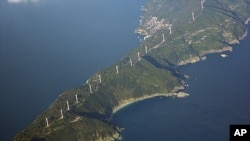Nearly 14 months after a powerful earthquake and tsunami triggered the most severe nuclear accident since Chernobyl, Japan is shutting down the last of its nuclear reactors. After the accident, the Japanese government imposed safety tests on all nuclear power plants. But public concerns about their safety have slowed down the process to restart the reactors, leaving Japan's nuclear industry with an uncertain future.
For the first time in 42 years, the portion of nuclear power in Japan’s energy mix is set to reach zero on Saturday night, when the last of the country’s 50 commercial reactors is taken offline at the Tomari plant in Hokkaido.
After the March, 2011 earthquake and tsunami caused meltdowns at the Fukushima Daiichi plant, the Japanese government imposed inspections known as stress tests on all nuclear reactors. One by one, they were required to shut down to check their resistance to earthquakes and tsunamis.
The first reactors to have cleared the process were units 3 and 4 at the Ohi nuclear plant in Fukui Prefecture, central Japan. In early April, the government decided they were ready to go back online, as explained by the deputy cabinet secretary for public relations Noriyuki Shikata.
"We have learned enough about the cause of the accident at the Fukushima Daiichi NPP and also what needs to be done in the case of the Ohi NPP supposing that a severe accident could take place at those locations," said Shikata.
Despite the government seal of approval none of the cleared reactors have been restarted.
The government argues that without nuclear power, parts of Japan - including the central Kansai region, where the Ohi plant is located - would suffer severe power shortages this summer.
However, local residents are not sure they want to see those reactors back online yet.
Opinion polls, both in Fukui Prefecture and at the national level, indicate a majority of the public is opposed to an immediate restart of nuclear plants. The governors of neighboring prefectures demand stronger guarantees and safety measures. They also question the idea that the Kansai region needs the reactors to make it through the summer.
Deputy Cabinet Secretary Shikata says the government hasn’t settled on a definite deadline for restarts. He says Tokyo remains committed to a "very intensive dialogue" with a broad base of stakeholders, including Fukui’s neighboring prefectures.
Shikata admits that failure to restart the Ohi plant before the summer is now among the scenarios considered by the government.
"We think it is appropriate and desirable to restart the Ohi NPP," added Shikata. "At the same time, we are assuming that no NPPs will be operating and the hot summer could come. If there continues to be very strong opposition or reservations, we will need to continue to engage the public, and this could be in the longer run reflected in the long-term energy mix for our economy or for our country."
In the meantime, Japan is compensating for the energy shortfall by relying on costly imports of coal, oil and natural gas. A situation that undermines Japan’s energy security, its economy, and the nation's greenhouse gas emissions.
News
Japan Shuts Down Last Nuclear Reactor






